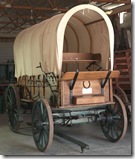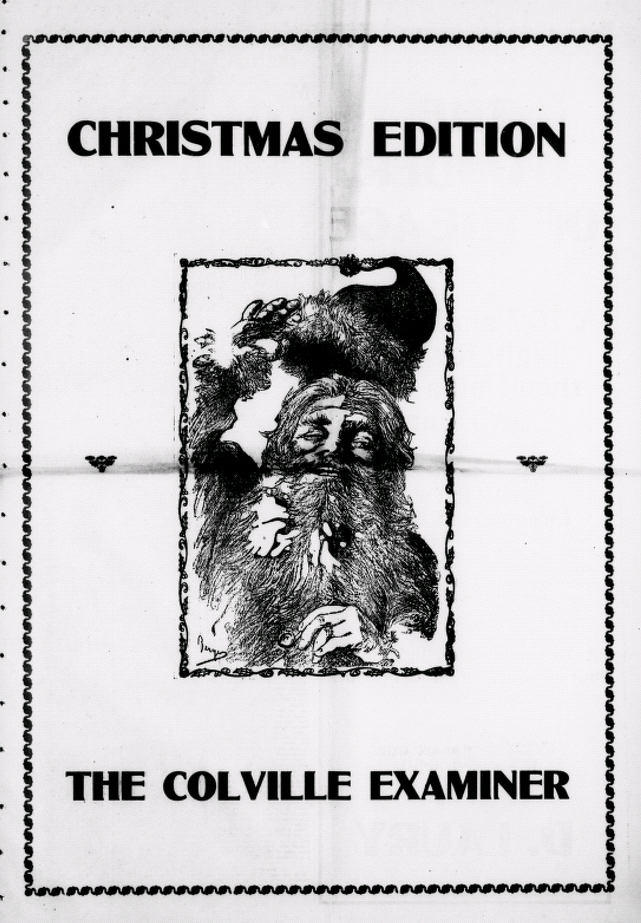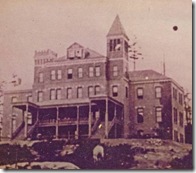February 23rd, 2010 Evan Posted in Articles, Digital Collections, For Libraries, For the Public Comments Off on New digital collection: Pomeroy Heritage
 Branded board from the Krouse
Branded board from the Krouse
Machine Shop–one of 184
historic, locally-registered brands
in the Pomeroy Heritage Collection.From the desk of Evan Robb
A new digital collection from the Washington Rural Heritage initiative documents early agricultural technology and domestic life in Washington’s least populous county (Garfield). The Denny Ashby Library in Pomeroy, Washington is kicking off its new project with a sub-collection of materials from its local partner, the Eastern Washington Agricultural Museum (EWAM). Washington Rural Heritage staff helped with imaging of the collection in 2009 and the Denny Ashby Library did a fantastic job of cataloging the items with help from community members and local experts at EWAM.
During our on-location project at EWAM, our hosts frequently demonstrated that expertise–interpreting the objects as we imaged them, pointing out their unique features and explaining how each tells a specific story about life in this part of the state. For example, this wagon had a customized wide rear axle so that it could be used while harvesting wheat on the steep, rugged hillsides of Garfield County. While admiring this horse drawn postal wagon/sleigh with miniature stove, we learned that the postmaster’s winter route sometimes took three days to complete. And as it turned out, the granddaughter of its primary driver lived right in town. She soon arrived on scene and gladly contributed this photo of her grandfather, “Skinny” Trescott, posing next to his mail sleigh.
Our EWAM hosts also half-jokingly mentioned that this 1912 windmill was kind of unique (for any American windmill) simply because there are no bullet holes in its vane. And that the standard line about this reversible plow is that it was for a farmer “who didn’t know whether he was coming or going”. Joking aside, much of the equipment at EWAM has been carefully restored and is still more than serviceable. The museum hosts an annual Spring Farming Days on its grounds where community members are invited to watch land be tilled and planted using horse drawn plows and implements.
The Denny Ashby Library is currently working on a grant-funded project to produce two additional sub-collections. One will document small rural schoolhouses of Garfield County. The other will focus on the Mayview Tramway, a unique method of transporting grain to market prior to railroad development in the region. Keep an eye out for those new collections, which will go live later this summer!





February 5th, 2010 Laura Posted in Articles, Digital Collections, For Libraries, Technology and Resources Comments Off on Digitizing Newspapers: Part III – Outsourcing
I got off a long conversation with our newspaper digitization vendor and thought I should do something cathartic … like continuing our running discussion of newspaper digitization.
Washington’s National Digital Newspaper Program (outsourcing):

Click to see OCR example from the Pullman Herald at 100% resolution
We last talked about the human resource intensive process of digitizing newspapers with a consumer-grade film scanner and the article-level indexing we do in-house for our Pioneer Newspaper collection.
In 2008 we were awarded an NDNP grant and began researching proposals to outsource the scanning and text conversion of 100,000 newspaper pages. OCR (optical character recognition) and scanning technology had come a long way since we began the Pioneer Newspaper collection so we were excited to see the results from our initial test scans. However, while outsourcing a large scale digitization project has its advantages, it also shares some of the same challenges already discussed, and produces a few unique ones:
Read the rest of this entry »

December 21st, 2009 Laura Posted in Articles, Digital Collections, For Libraries, For the Public Comments Off on 8 Washington Newspapers Added to Chronicling America!

Front page of the Colville Examiner
December 18, 1909
On Friday, December 18, more than 42,000 historic newspaper pages from 8 Washington newspapers were contributed by the Washington State Library to the Chronicling America web site, hosted by the Library of Congress. The site provides free and open access to over 1.7 million pages from 212 titles, that were published between 1880 and 1922 in 15 states and the District of Columbia. More pages from other newspapers around Washington State will be periodically uploaded throughout 2010 as part of WSL’s National Digital Newspaper Program (NDNP) grant. Pages will also be loaded locally and included in the WSL’s existing Historic Newspapers in Washington collection.
Representation from Washington State Newspapers:
Chronicling America is a project of the National Digital Newspaper Program, a partnership between multiple organizations including the Washington State Library, the National Endowment for the Humanities and the Library of Congress … Read more about it!
Contact Laura Robinson, National Digital Newspaper Program Manager, [email protected], 360.570.5568, for more information about Washington State’s participation in NDNP.

December 4th, 2009 Evan Posted in Articles, Digital Collections, For Libraries, For the Public Comments Off on New digital collection: Vashon Island Heritage




From the desk of Evan Robb
The Washington Rural Heritage initiative is pleased to announce our newest digital collection: Vashon Island Heritage. A project of the Vashon Library (King County Library System) and the Vashon-Maury Island Heritage Association, the collection documents life on the island from the late 1800s through the 1960s. Four sub-collections make up the collection:
- Journals & Memoirs features local histories such as Marjorie Rose Stanley’s Search for Laughter and Bill Rendall’s Memoirs of Maury Island. Our favorite item in this sub-collection is a scrapbook documenting a mother and daughter’s 1923 move from Michigan to Paradise Cove on Vashon Island. Florence Harger Burd painstakingly recorded her daughter Tad’s early years in this scrapbook, which includes photos, letters, artwork, and a journal narrating their day-to-day activities. Here’s a good place to begin exploring this large scrapbook.
- Maps and Periodicals includes maps from c.1895 through the 1920s, and some of the Island’s earliest newspapers and publications. During the 1930s Islander Janet Haugen founded a monthly magazine called the Nor’Wester, which featured many stories of Vashon’s pioneers and farmers. Here’s a Nor’Wester story about one of those early pioneers.
- Vashon’s First Peoples documents the S’Homamish people of Vashon Island. It includes images of traditional tools and baskets on display at the Vashon Heritage Museum, and details life on the Island prior to S’Homamish removal to the Puyallup Reservation. Born in a longhouse on Quartermaster Harbor in the 1840s, native S’Homamish Lucy Gerand would later provide vital information regarding the island’s native population and traditional place names. Here are some of those names, told by Lucy to anthropologist T.T. Waterman in 1922.
- Vashon College (1892-1912) includes photos and memorabilia documenting the first college on Vashon Island, which operated from 1892-1912, when fire destroyed key buildings (Vashon College resumed operation as a Washington State nonprofit in 2005, and contributed material for this digital collection).
A big thanks to our participants at the Vashon Library and Vashon-Maury Island Heritage Association for their hard work digitizing and cataloging these materials!





November 20th, 2009 Judy Pitchford Posted in Articles, Digital Collections, For Libraries, For the Public, News Comments Off on Digital Updates
From the desk of Judy Pitchford
Volume 4, #2 November 2009 for Digital Updates
Historical Newspapers in Washington – 1 new title.
The years 1861-1864 have been added to the Puget Sound Herald in Historical Newspapers in Washington online project, which now covers six years of Steilacoom pioneer news, from 1858 to 1864.
Classics in Washington History
We have added a new category – 20th Century Events – to our Classics in Washington History. This category currently contains the Works Progress Administration Papers and, new to the collection, papers by the War Relocation Authority on the Japanese Internment :
The Community Analysis Report concerns how authorities should “deal” with the Japanese and Japanese American people they have incarcerated through an understanding of their customs and cultural background. Causes of social unrest, segregation, education, Buddhism and labor relations are topics covered within these papers.
The Community Analysis Notes “reveal the life experience and viewpoints” of the incarcerated Nisei. Why did many young men say “no” to two questions on the Army registration form? How did the Japanese deal with engagement and marriage in the camps? How did it differ from pre-internment days? How did they adjust to life in the camps?
The Project Analysis Series analyzes various events that occurred during the relocation project. What happened at Tule Lake in November 1943? Why did it happen? What was the reaction to opening Selective Service to Nisei? What are the motives behind Nisei requesting repatriation?
Read the rest of this entry »

October 29th, 2009 Judy Pitchford Posted in Articles, Digital Collections, For the Public Comments Off on Japanese Internment Papers

Quarters at Manzanar, a War Relocation Authority center for evacuees of Japanese ancestry (NARA)
From the desk of Judy Pitchford
The War Relocation Authority (WRA) was a civilian agency in charge of the internment of Japanese Americans during World War II. The WRA staff documented the internment with reports by community analysts assigned to the relocation centers. These reports analyze the Japanese culture within the camps, reactions of the Japanese Americans to being incarcerated and interviews with “evacuees”.
The Washington State Library Federal Collection contains three sets of WRA reports, which we have also added to our digital collection.
The Community Analysis Notes “reveal the life experience and viewpoints” of the incarcerated Nisei. Why did many young men say “no” to two questions on the Army registration form? How did the Japanese deal with engagement and marriage in the camps? How did it differ from pre-internment days? How did they adjust to life in the camps?
The Community Analysis Report concerns how authorities should “deal” with the Japanese and Japanese American people they have incarcerated through an understanding of their customs and cultural background. Causes of social unrest, segregation, education, Buddhism and labor relations are topics covered within these papers.
The Project Analysis Series analyzes various events that occurred during the relocation project. What happened at Tule Lake in November 1943? Why did it happen? What was the reaction to opening Selective Service to Nisei? What are the motives behind Nisei requesting repatriation?
To find the answers to these questions and learn many other fascinating details of this tragic time in history, visit 20th Century Events in our Classics in Washington History.

September 4th, 2009 Evan Posted in Articles, Digital Collections, For Libraries, For the Public Comments Off on New Material for San Juan Island Heritage




From the desk of Evan Robb
Over the course of three intensive community digitization events last Winter, the San Juan Island Library pulled together an impressive array of materials for its 2008-2009 Washington Rural Heritage grant project. The Library asked its patrons to share historically significant photos, documents, and objects from their private collections, and they responded with zeal. The resulting San Juan Story Collection provides a fascinating look at the early people and places of San Juan Island.
I was present to help out with large-format scanning for the first event back in February, and was impressed by the operation. Community members filed into the Friday Harbor High School library on a Saturday afternoon, items in hand. There, they were greeted by Library staff and volunteers trained to scan materials and record detailed information about each item. In the main room, two flatbed scanners were kept humming all afternoon. In another room, three-dimensional objects and artifacts were photographed in an ad hoc studio. And in a quieter section of the library, a historian from San Juan Island National Historical Park recorded interviews with long-time island residents and natives. Islanders were able to hold on to their family treasures, leave with a digital copy in hand, and know that they had just made an important contribution to the telling of their town’s story.
A few highlights from this diverse collection include: Indian arrowheads found throughout the island; locally produced crafts like this tobacco sack quilt or this casserole dish; individual and group portraits; aerial views from around the Island; San Juan County’s first ambulance airplane; and the Islander, an early steamboat ferry.
View San Juan Island Library’s entire collection at http://www.washingtonruralheritage.org/sanjuan. To see their newest 2008 grant material, click here.





September 2nd, 2009 Kirsten Furl Posted in Articles, Digital Collections, For Libraries, For the Public, Grants and Funding Comments Off on New Material for Ellensburg Heritage




Washington Rural Heritage introduced Ellensburg Heritage last year with the stunning Rodeo Collection, documenting 40 years of one of the top 25 rodeos in the country. Their sophomore effort brings us three new collections (and a few more rodeo photographs, too!).
The Kittitas Valley Crossroads Collection contains nearly 200 historic images depicting Indian life in Ellensburg and the surrounding area. It features the work of local photographers as well as a sampling from Eli Emor James, Lee Moorhouse, Vibert Jeffers, and Frank Matsura. The images include portraits of Indians in both traditional and Western dress, photos of pictographs from Rock Island, and scenes of recreation and domestic life.
The Ida Nason Collection is the personal photograph collection of Ellensburg citizen Ida Joseph Nason Aronica. A great-granddaughter of Yakama Chief Owhi, she dedicated her life to the preservation of her native heritage and culture. See images of her weaving and beadwork, family photos – her daughters were Ellensburg Rodeo royalty in 1929, and beautiful portraits of Ida as a young girl and in her later years.
The Fred L. Breckon Historic Portraits Collection is the work of amateur photographer Fred Beckon, an Ellensburg native who captured his fellow citizens in candid shots around town. These portraits date from the early 1940s to 1966 and are accompanied by short biographical information jotted down at the time the photo was taken, giving a very personal glimpse into Ellensburg’s history. Learn more about everyone from a poet to the postmaster.
View Ellensburg Public Library’s entire collection at: http://www.washingtonruralheritage.org/ellensburg. To view their newest 2008 grant material, click here.





September 1st, 2009 Evan Posted in Articles, Digital Collections, For Libraries, For the Public, Grants and Funding Comments Off on New Material for Lummi Island Heritage
 Reefnet fishing in Row 3, ca. 1956.
Reefnet fishing in Row 3, ca. 1956.
Click image to see full record.From the desk of Evan Robb
For the second year in a row, Lummi Island Library (Whatcom County Library System) has built upon its Washington Rural Heritage collection by documenting the history of reefnet fishing around Lummi Island, Washington. First practiced by the Lummi Indians using cedar nets and stone anchors, this salmon fishing technique saw a resurgence in the early 20th century; as many as 70+ reefnet boats once set their gear around the Inner Puget Sound, and a small number of reef netters still practice today.
The Friends of the Island Library (FOIL) led this 2008 grant project, bringing together a truly diverse set of materials, most of which came from the private collections of island residents. The new collection includes: maps showing reefnet gear locations in various years; records of the Puget Sound Reefnetters Union; images of traditional fishing gear; and a variety of documents telling the story of a 1954 initiative which threatened to eliminate the reef net fishery altogether.
 Edola Brand Label, Lummi Bay Packing Co.
Edola Brand Label, Lummi Bay Packing Co.
Click image to see full record.Perhaps the most exciting material in the new collection comes in the form of roughly 50 oral histories recorded by islander Kim Gardner, daughter of a reefnet fisherman and reef netter herself. Kim sat down with a number of veteran fisherman this summer and got their stories about everything from the evolution of reefnetting techniques, to record catches, to legal battles surrounding the reefnet industry. Below are some of our favorite interviews (when the record displays, click on “Access this item” to download the mp3):
View Lummi Island Library’s entire collection at: www.washingtonruralheritage.org/lummi. To view their newest 2008 grant material, click here.

August 31st, 2009 Laura Posted in Articles, Digital Collections, For Libraries Comments Off on Libraries and Copyright

The Section 108 Spinner; available to help Librarians navigate the morass that is Section 108 of the US Copyright Code
I have a love/hate relationship with the copyright exceptions for libraries and researchers. I’m grateful there are exceptions but I’m just not sure it’s possible things could be *more* confusing.
Kudos to the Copyright Advisory Network (http://librarycopyright.net) for these easy-to-use tools to help libraries and others understand these confusing rules.
For librarians the Section 108 Spinner:
http://librarycopyright.net/108spinner/
For teachers the Exceptions for Instructors tool:
http://librarycopyright.net/etool/
For researches (and everyone) the Public Domain Slider and the Fair Use Evaluator:
http://librarycopyright.net/fairuse/
http://librarycopyright.net/digitalslider/
 Branded board from the Krouse
Branded board from the Krouse






































